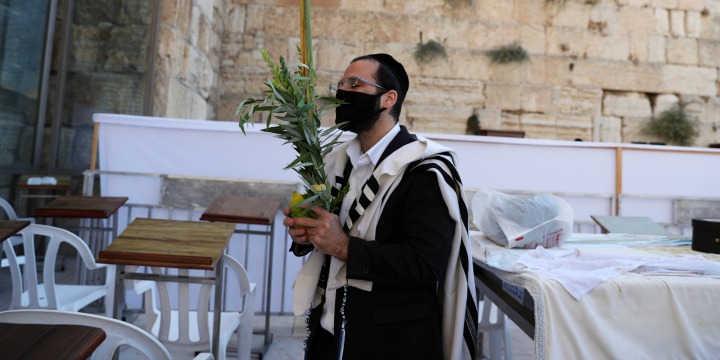A Sukkot Guide for the Perplexed
 by Yoram Ettinger
by Yoram Ettinger

A Jewish worshipper holds the Four Species, used in rituals on the holiday of Sukkot, as he takes part in the priestly blessing at the Western Wall, Judaism’s holiest prayer site, amid Israel’s second-wave coronavirus disease (COVID-19) lockdown, in Jerusalem’s Old City, Oct. 5, 2020. Photo: Reuters / Ronen Zvulun.
Here are some facts you may not know about the upcoming holiday of Sukkot.
1. The holiday is named for the first stop during the 40-year-Exodus from Egypt — the town of Sukkot — as documented in Exodus 13:20-22 and Numbers 33:3-5. This holiday underscores the gradual transition from the spiritual state-of-mind during Rosh Hashanah and Yom Kippur, to the mundane of the rest of the year. The construction of the Holy Tabernacle, during the Exodus, was launched on the first day of Sukkot.
2. Sukkot is a national Jewish liberation holiday. It is the third Jewish pilgrimage holiday (following Passover and Shavuot).
3. The roots of the Hebrew word Sukkot (סוכות) are wholeness and totality (סכ), shelter (סכך), and attentiveness (סכת).
4. The seven days of Sukkot are dedicated to seven monumental principle-driven leaders, who were compassionate and brave shepherds: Abraham, Isaac, Jacob, Joseph, Moses, Aaron and David. They were endowed with faith, reality-based-optimism, humility, compassion, tenacity in the face of daunting odds, courage, and peace-through-strength. Sukkot also expresses gratitude for the seven species of the Land of Israel: wheat, barley, grapes, figs, pomegranates, olives, and dates.
5. Sukkot features (Leviticus 23:40) one citron (representing King David, the author of “Psalms”), one palm branch (representing Joseph), three myrtle branches (representing the three Patriarchs), and two willow branches (representing Moses and Aharon), which are bonded together, representing the unity-through-diversity of the Jewish people.
These four species represent the agricultural regions of the Land of Israel: the southern Negev and Arava (palm), the slopes of the northern Golan Heights, Upper Galilee, and Mt. Carmel (myrtle), the streams of the central mountains of Judea and Samaria (willow), and the western coastal plain (citron).
The palm branch, an ancient symbol of victory, was featured in coins from the Maccabees’ era (from the second century BC through the first century AD), and the Bar Kochba rebellion (132-135 AD). According to the First Book of Maccabees, chapter 13, Simon the Maccabee celebrated the retaking of David’s Citadel in Jerusalem with drums, harps, and palm branches.
6. Sukkot emphasizes humility, as demonstrated by the seven-day-relocation from one’s permanent residence to the temporary, humble, wooden booth (Sukkah), which sheltered the people of Israel during the Exodus.
7. Sukkot expresses the yearning for universal peace, highlighting the Sukkah of Peace (Sukkat Shalom).
Yoram Ettinger is a former ambassador and head of “Second Thought: a U.S.-Israel initiative.”
 Police Stop Anti-Zionist Agitators From Accessing Florida University President’s Home as Students Revolt Nationwide
Police Stop Anti-Zionist Agitators From Accessing Florida University President’s Home as Students Revolt Nationwide Nearly One in Five Young People Sympathize With Hamas, 29% Say US Should Reduce or End Alliance With Israel: Poll
Nearly One in Five Young People Sympathize With Hamas, 29% Say US Should Reduce or End Alliance With Israel: Poll Ilhan Omar Silent After Daughter’s Arrest, Suspension for Role in Columbia University Anti-Israel Protest
Ilhan Omar Silent After Daughter’s Arrest, Suspension for Role in Columbia University Anti-Israel Protest Cultural Center Backed by Iran’s Revolutionary Guard Plans to Produce Films About Attack on Israel
Cultural Center Backed by Iran’s Revolutionary Guard Plans to Produce Films About Attack on Israel How Does Ilhan Omar Really Feel About Iran?
How Does Ilhan Omar Really Feel About Iran? This Passover, Combine Respect for Tradition with the Courage to Innovate
This Passover, Combine Respect for Tradition with the Courage to Innovate Israel’s Iran Attack Carefully Calibrated After Internal Splits, US Pressure
Israel’s Iran Attack Carefully Calibrated After Internal Splits, US Pressure Palestinian Cameramen Exposed in New Footage Documenting Oct. 7 Atrocities Side by Side with Terrorists
Palestinian Cameramen Exposed in New Footage Documenting Oct. 7 Atrocities Side by Side with Terrorists US Money to Convicted Terrorists; US Training to Aspiring Terrorists
US Money to Convicted Terrorists; US Training to Aspiring Terrorists Man Arrested in Paris After Iran Consulate Incident
Man Arrested in Paris After Iran Consulate Incident



 Palestinian Cameramen Exposed in New Footage Documenting Oct. 7 Atrocities Side by Side with Terrorists
Palestinian Cameramen Exposed in New Footage Documenting Oct. 7 Atrocities Side by Side with Terrorists Israel’s Iran Attack Carefully Calibrated After Internal Splits, US Pressure
Israel’s Iran Attack Carefully Calibrated After Internal Splits, US Pressure This Passover, Combine Respect for Tradition with the Courage to Innovate
This Passover, Combine Respect for Tradition with the Courage to Innovate How Does Ilhan Omar Really Feel About Iran?
How Does Ilhan Omar Really Feel About Iran? Cultural Center Backed by Iran’s Revolutionary Guard Plans to Produce Films About Attack on Israel
Cultural Center Backed by Iran’s Revolutionary Guard Plans to Produce Films About Attack on Israel